
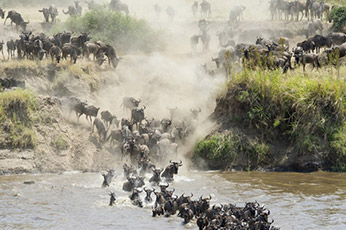
Close to 2 million wildebeest are constantly on the move accompanied by thousands of zebras and elands. This spectacular event takes place throughout the year. The Great Migration, with which most visitors are familiar, takes place both in Kenya and Tanzania. By crossing the Mara River, they verge into Kenya, but for the rest of the year, they move from the Mara River back into the plains of Central Serengeti and then down to southern plains. Each season features a different pattern, different landscape, with the thrilling action staying constant.
Even if the wildlife movement and its precise location is highly unpredictable, the migration typically follows more or less the same pattern. We, at KiliTwende Adventures Ltd, customize our safari itinerary as per the migration movement. The four season that we have categorized are as follows.
Season One: The Calving Season
Late January and March | Southern Serengeti & Ndutu plains (NCAA)
The Great migration viewing experiences goes into the next level during the calving season. Over a million wildebeest and zebras gather in the southern plains every year. January and early March is the calving season which can sometimes extend beyond the timeframe depending on the rain pattern. This is an excellent time to visit Tanzania as you’ll get to spend time amidst the larger herds of zebras and wildebeests. The herds gather between Southern Serengeti and Ndutu plains and thousands of the members give birth to their young ones at once. As the soil of the southern plains is composed of volcanic materials, they are rich in minerals which facilitate growth of nutrient-dense rich grass which in turn is beneficial for mothers and their young ones. As a result, this attracts large groups of predatory animals such as lions, cheetahs, leopards and hyenas, to prey on the young and the weak. With luck and exceptional guiding, you will have a chance to see thrilling chase and stumbling upon young cubs and the newborn!
Season Two: Green Season & Grumeti River Crossing
April to early July | Western& Central-West Serengeti (Ikoma region)
April and May are the long rain season months in Tanzania. While many avoid these months for going on a safari tour, it can be as spectacular and rewarding as other high-season months. The rainfall rejuvenates the dried-out plains and gives it a brand new lush green coating. This turns into a replenished heaven for resident herders that dwell within. The rain generally occurs in early morning and evening leaving the noon unaffected which doesn’t hinder the game drives. The rates of accommodation and tour packages themselves are low as the months fall into the “low season” in Tanzania.
As the rainfall shifts from southern to the western Serengeti, the herds subsequently migrate into the western corridor, where they’ll ultimately cross the Grumeti River. Even though it is not as grandeur as the Mara River crossing event, it is also a highly anticipated event of the Great Migration. The Grumeti River is home to Nile crocodiles which are regarded as the world’s largest crocodiles. These pose as the biggest threat to the wildebeests and zebras.
The Western corridor is also enjoys a diverse topography which includes floodplains, savannahs, scattered forest plains, open woodlands, small hills, and valleys. This territory is home to rare colobus monkeys, herds of elephants, and giraffes. Pride of resident lions can be seen round the year in the area.
In the months of June and July, the migrating herds will begin to move upwards to Northern Serengeti, passing through the Grumeti reserve and Ikoma area. For those who have a longer itinerary, we would recommend spending time in both the Western Corridor, and the Kogatende area in the Northern Serengeti.
As April and May are part of the long rain season, the rainfall will be sporadic throughout the day, though the heavier rain typically occurs in the early morning and evening time. Contradictory to general belief, the rain doesn’t stop the game viewing; rather, the cool weather after the rain makes the wildlife more active.
Season Three: Dry Season & the Mara Crossing
Mid-July to October | Northern Serengeti (Lobo, Bologonya and Kogatende)
Typically, from mid-July, herd in large numbers would have made it to the Kogatende area to start crossing the Mara River. They’d have eaten up all the grass and fodder of the western corridor and Grumeti. The northern Serengeti is comparatively pristine to the areas of Central Serengeti, Seronera, as well as its Kenyan counterpart, Maasai Mara. This is so because northern Serengeti is only being explored by tourists recently and before that, it remained almost secluded. The location of the herds primarily depends on the rainfall pattern. If it is a dry year, then the herds might be located at the Mara River by early July. If it’s a wet year, the herds slow down a bit and arrive at the river by mid-August. The northern part of Serengeti is adorned with many kopjes, small and medium-sized hills, thick woodlands which serve as a hiding place for the Big Cats. But the leopards are more elusive in this area, with lions, hyenas, and cheetah being regularly spotted during the day time. Other resident game includes hippo, giraffe, impala, topi, Thomson’s gazelle, and elephant.
The Mara River Crossing is a must-see event if you’re a wildlife enthusiast. Both the size and scope of this river crossing is baffling. Only the fittest and luckiest of the wildebeests and zebras make it to the other side escaping the hungry predators. It is important to note for those who plan to visit during this time for the river crossing, that the exact timing of the crossing cannot be guaranteed, as the migration location will ultimately depend on the rainfall pattern. Also, witnessing the crossing does require a lot of patience, as well as how many days you are able to spend waiting by the riverbank. It is generally advised to the tourists to spend at least two to three nights in the northern corner of Serengeti as part of their safari trip which increases their chances of witnessing the crossing event during this time. Our experienced driver guides who know the area inside out will seek out the best location for a good viewing of the crossing, and be there to give you interesting facts and information about the migration and the Northern Serengeti while you wait for the crossing.
Season Four: Short Rain Season
Mid October to November | Central Serengeti & Western Serengeti
As the migratory herds move back into Tanzania, they get divided into three groups each of which follows a different route to western, central, or eastern Serengeti. Central Serengeti typically attracts larger number of herds. As the eastern corridor is less accessible, western and central Serengeti are the first choice for the migrating herds.
The Central Serengeti is rich in resident game, and with the addition of migrating herds, the game viewing becomes even more diverse and exciting. The resident predators hunt the herds and prey-predator action becomes common. Scattered forests, Seronera valley, and open plains together make the area an easy access with more grounds to cover when compared to eastern and western corridor. For those seeking a more exclusive game drive during this time frame, western Serengeti might be the preferred option. If you’re staying in lodges located in central Serengeti, then getting to western Serengeti is no big deal.
The months of November and early December are considered low season and this is when the parks are less crowded. This enables for a more intimate and private game drive compared to rush seasons. The rainfall also plays its part and makes game viewing even more exciting. Another advantage of coming in low season is the cost as many lodges lower their price during these months.
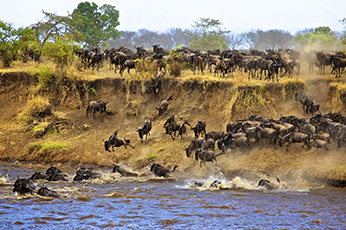
From Arusha, we’ll advance towards the Tarangire Natinla Park where game drives will be conducted. It is among the largest national parks of Tanzania with its location in the Manyara region. This is the place where elephants, tree climbing lions are found in large numbers along with the fascinating baobab trees also called the Tree of Life for its almost mythical powers that some cultures attach to it. This park is especially known for Tarangire River which flows all year round and the only source of water for wild animals during dry seasons.Late afternoon drive to the campsite for Dinner and overnightas per the standard and type of accommodation option requested.

After breakfast, we proceed to the Central part of Serengeti. This park is well-known for its healthy stock of resident wildlife, particularly the "big five", named for the five most prized trophies taken by hunters: Lion, Leopard, Elephant, Buffaloes, and Rhinos.Dinner and overnightas per the standard and type of accommodation option requested.
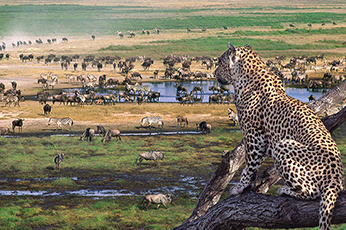
After savouring on the morning breakfast, we’ll set off for a full day game drive into the Serengeti wilderness following the Great Migration trails. Our experienced driver tour guide will provide you with interesting facts about this highly renowned event, which makes Tanzania the top safari destination in Africa.
Serengeti which is a World Heritage Site designated by UNESCO is home to around 200,000 zebras and 300,000 Thomson’s gazelle which join in with the migrating herds of wildebeest in search of fresh grazing land. Keep your ears open and listen to the hymns and squeaks of over six million hooves pounding the savannah and open plains. This is so typical Africa.Dinner and overnightas per the standard and type of accommodation option requested.
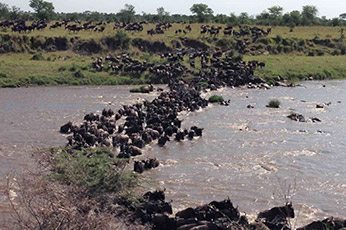
We’ll be setting off to the Mara area to view the great migration on a full day basis. In the Wagakuria area, the resident animals are exceptionally high in number. But the key feature of the Mara area is the Mara River which offers excellent opportunities to witness the river crossing event. Herds can be seen crossing north on one day and make their way back the other day. But this is an unpredictable event which can be just a matter of luck. The area is further adorned by kopjes, woodland, riverine vegetation, and grassland which are similar to that of Masai Mara Game Reserve.Dinner and overnightas per the standard and type of accommodation option requested.
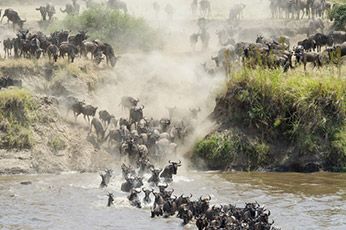
After breakfast, we will drive to Serengeti north viewing the great migration at Mara area. The main highlight of this area is the Mara River and the herds crossing the Mara River on the first day and coming back few days later is not an uncommon sight. But it should be noted that timing the crossing event is challenging and sometimes depend solely on luck. There are instances where herds can be seen right next to the river but might cross it after two or three days have gone by. The area is further adorned by kopjes, woodland, riverine vegetation, and grassland which are similar to that of Masai Mara Game Reserve.Dinner and overnightas per the standard and type of accommodation option requested.
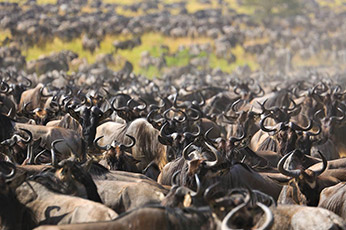
In the morning, we will have another game drive in Serengeti National Park. Likewise in the afternoon, we’ll proceed for the Ngorongoro Conservation Area and visit the Olduvai Gorge museum which is a renowned archaeological site in East Africa. At Laetoli, which is located 45 km south of Olduvai Gorge, you’ll find footprints of early hominin. These remain preserved in the volcanic rocks and date back 3.6 million years ago and represent some of the earliest signs of mankind in the world.Dinner and overnightas per the standard and type of accommodation option requested.
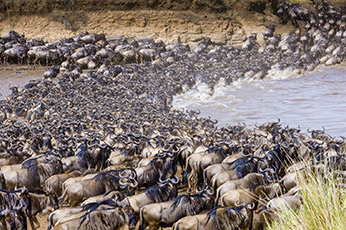
The final day kicks off with an early morning game drive inside the Ngorongoro Crater. The whole of Ngorongoro Conservation Area is a highland area and the crater is its focal point. It stretches along the Rift Valley system and regarded as its eastern arm. The conservation area was established with the purpose to conserve wildlife and other natural resources. It further safeguards the interest and morale of indigenous people and promotes sustainable tourism.Dinner and overnightas per the standard and type of accommodation option requested.

After breakfast, we make our way back to Arusha or at the airport for your flight back home.
© 2022 ,Kilitwende Adventures Limited. All rights reserved.